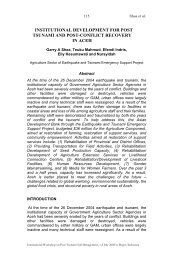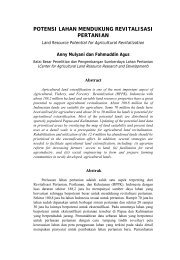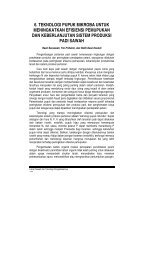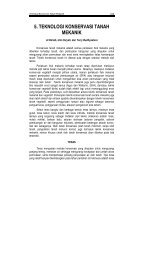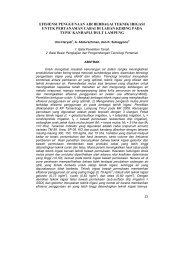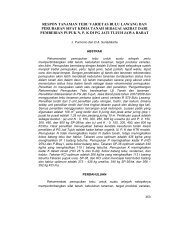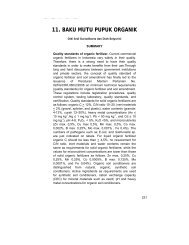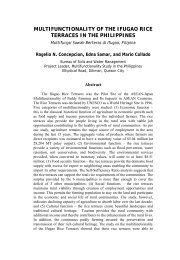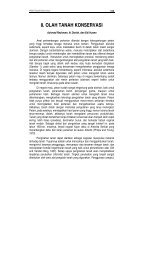Proceedings - Balai Penelitian Tanah
Proceedings - Balai Penelitian Tanah
Proceedings - Balai Penelitian Tanah
Create successful ePaper yourself
Turn your PDF publications into a flip-book with our unique Google optimized e-Paper software.
INTRODUCTION<br />
138<br />
Wahyunto et al.<br />
The agricultural sector played an important role in the economic<br />
development of Nanggroe Aceh Darussalam (NAD) Province prior to<br />
the 2004 tsunami. It contributed around 60% of village income, and<br />
about 48% of villagers engage in agriculture (Subagyono et al., 2005).<br />
Agricultural land along the coast affected by tsunami in Aceh Barat<br />
district including perennial tree crops and annual crops, was about<br />
24.7%. The disaster caused at least 6,7% (763 family) farms death or<br />
disappeared and 64% irrigation network damages (Dinas Pertanian<br />
Tanaman Pangan dan Hortikultura Provinsi NAD, 2005).<br />
Dense tree cover along the coastal line can attenuate the power of<br />
small and moderate waves of a tsunami. Tree crops provide<br />
sustainable livelihoods and environmental protection. Efforts to<br />
reconstruct agriculture, including the tree crop component, need to be<br />
accelerated to prepare farmers to depend again on themselves after<br />
being heavily supported. Reconstruction of damaged land requires<br />
careful planning based on nature and suitability of land for different<br />
crops.<br />
The requirements for growth of various crops can be obtained from a<br />
guideline developed by Indonesian Soil Research Institute in 2003.<br />
Land evaluation is conducted by matching (comparing) between land<br />
characteristics in every mapping unit with its crop requirements. The<br />
process can be carried out by computerized system such as the<br />
Automated Land Evaluation System (ALES) software or manually if<br />
only a few points or mapping units are to be evaluated. Land suitability<br />
classifications are defined based on their most serious limiting factors.<br />
The result of land evaluation will give information or guidance for<br />
proper land uses and finally, it will give the value of expected<br />
production. In this regard, an appropriate methodology supported by<br />
accurate data and information will be most important element<br />
concerning the land-use planning. Remote sensing and GIS<br />
techniques provide an efficient technology with capabilities of<br />
capturing, generating and analyzing the spatial data as well as<br />
integrating the statistical and quantitative data. The purpose of study<br />
is to have relatively accurate information for that part of tsunami<br />
disaster affected areas especially for coastal region of Aceh Barat<br />
district that has potential for development of tree crops and other<br />
agricultural crops, through land evaluation assessment by applying<br />
remote sensing and GIS techniques approach.<br />
MATERIALS AND METHODS<br />
The following images and maps were used in this study: (1) Satellite<br />
images including Landsat TM-5 and Landsat-7 taken in 2003 and<br />
International Workshop on Post Tsunami Soil Management, 1-2 July 2008 in Bogor, Indonesia



